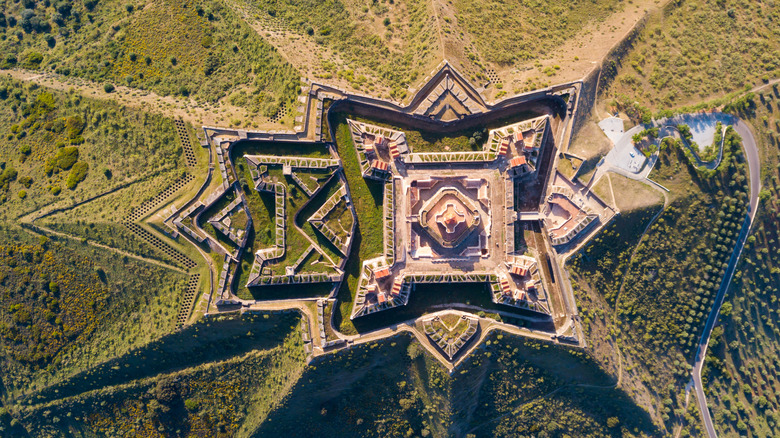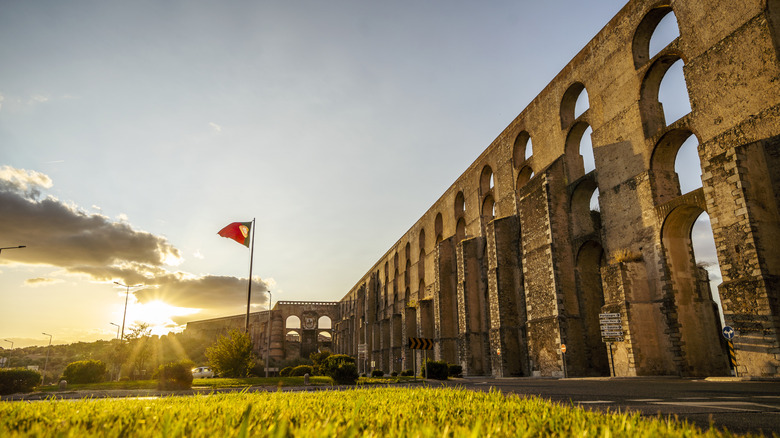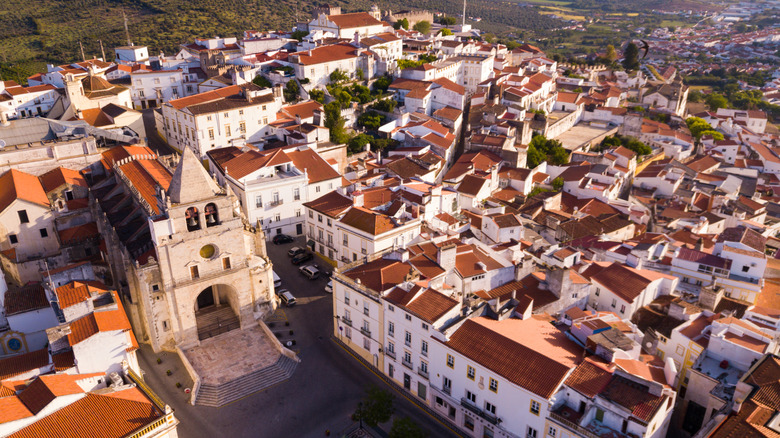Portugal's 'Queen Of The Border' Is A Grandiose City With Star-Shaped Forts And Free-Flowing Wine
On the border of Spain's Extremadura region, one tiny border town defended Portugal's hard-won independence unceasingly between the 17th and 19th centuries, following the Restoration War. A city overseen by two star-shaped fortresses, in the cunning "trace italienne" defensive style. In fact, the well-preserved fortifications of once-illustrious Alentejo's "Queen of the Border," Elvas, earned it UNESCO World Heritage status in 2012. Designed by a Dutch Jesuit priest, the walls of Forts Nossa Senhora da Graça and Santa Luzia warded off the Spanish Army and Napoleonic French for nearly 200 years, yet still they stand — masterpieces harkening back to less-settled times.
Though isolated in its outlandish location, as the largest fortified city in Europe, Elvas is well worth your visit. And while the forts' mystical multi-pointed star shapes can only truly be appreciated from on high, Elvas still has plenty to see and do at ground level — including visiting its 5-mile-long aqueduct and tasting the arid-sun-ripened wines of Alentejo's celebrated wine cellars.
A walk through historical Elvas
Initially conceived of in 1498, the Amoreira Aqueduct predates Elvas' legacy as a garrison post, and it's one of the most impressive sites in town. Four storeys of tiered buttresses hold piping that, to this day, supplies the city with water. To get there from the city center, walk southwest in the direction of the N4 to reach the viewing site, about 15 minutes away. Return to the Walled City via the canary yellow Portas da Esquina, tracing the bastioned ramparts on the way to Elvas Castle — an imposing fortress built by the Moors around 700 A.D. that now dominates the entire city.
Turn south to where the explorative Manueline-style Nossa Senhora da Assunção Cathedral watches over the Praça da República, and enter if you wish to view its well-preserved tilework. This may be a good time to pause and enjoy some petiscos (Portuguese tapas) with a robust aragonês,antão vaz, or port in one of the wine bars on the square. While it may not be as well-known as the Douro Valley, one of the oldest and most beautiful wine regions in the world, travel expert Rick Steves says the Alentejo region produces some of the best drops in Portugal.
The first of the city's star forts, the Santa Luzia, is just a 20-minute walk south from here. Built in the 17th century, the fort now houses a military museum, open from 10 a.m. to 6 p.m. Tuesday through Sunday. From its walls, you can see across the stretching countryside and across town to its sister star, Forte de Nossa Senhora da Graça. Constructed in the 18th century to complement Santa Luzia, Graça resides a couple of miles north of town. With its northern-facing swordlike protrusion, the latter's design is certainly more striking, but getting there may require a drive.
How to get there and where to stay
Elvas is about a two-hour drive east of Lisbon on the A6, so while you can reach the town in a day, you may want to consider spending the night. For the perfect midway break on your drive, stop off in Évora, a Portuguese gem with laid-back local vibes. Visitors to Extremadura can easily reach the town as well — it's just a one-hour drive west of Mérida. The nearest train station is in Badajoz, 12 miles east across the Spanish border. And while you can't get there on a Flixbus, an affordable way to move between European cities, regional buses will travel to Elvas directly from Lisbon and can cost as little as $5 as of this publication.
In terms of stays around town, the Vila Galé Collection Elvas provides a sumptuous stay in a converted 18th-century convent, complete with Turkish spa and fine dining. Or the Hotel São João de Deus by Ridan offers a similar experience in a rustically refurbished 17th-century convent with shady gardens. If you prefer a more personal touch, guesthouses and B&Bs are also available. Nearby, you could consider spending the night in Campo Maior (about a 20-minute drive north) or Évora, or even Badajoz, for a more in-depth exploration of the opposing force's side of the story.


